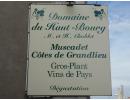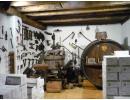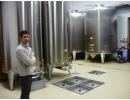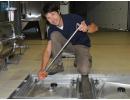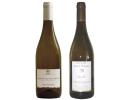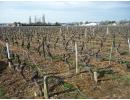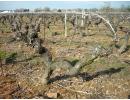Domaine du Haut Bourg
Domaine du Haut Bourg "Pavillon" - Muscadet Côtes de Grandlieu Sur Lie
This is the premium wine of the Domaine. The Muscadet vines on the "Pavillon" parcel average 40 years of age producing a yield of 45hl/ha. In the winemaking, 30% of the harvest will go through some skin maceration before the fermentation to extract colour, texture and extra flavours. Stainless steel vats are used for the fermentations that will last 2 weeks at 16°C - 18°C. The wine is aged in vats on fine lees "Sur Lie" for 8 months with “bâtonnage” meaning stirring of the lees to gain depth and richness.
PVins notes: There is no oak used in the winemaking process, letting the Melon de Bourgogne grape and the terroir fully express their characteristics. In many cases, the Muscadets have a reputation for being simple wines mainly good with oysters, but “Le Pavillon” delivers body and structure which will be well suited with crab meat, lobster and fish with a sauce. The wine can be cellared for 4 to 5 years.
Domaine du Haut Bourg is situated in the heart of the appellation Muscadet Côtes de Grandlieu. The Domaine was created in 1944 in the village of Bouaye located 15 kms southwest of Nantes. Today, the estate is managed by the brothers Hervé and Nicolas CHOBLET representing the 4th generation of winemakers in the family.
The first vines were planted in 1945 and today the Domaine’s vineyards represent 40 ha on the commune of Bouaye located 15 kms southwest of Nantes. The estate practices sustainable farming and is Terra Vitis certified. The vine density ranges from 6,500 to 7,000 per hectare and grass is left to grow between rows for biodiversity. The average age of the vines is 30 years old with some old Muscadet reaching 70 years old. The soil’s structure mainly contains mica schist, granite, quartz pebbles and red sand which provide a good balance and richness to the wines.
Various grape varieties are planted on the estate with the Muscadet representing the largest area with 23 ha. The other 17 ha are planted with grapes to produce IGP (Indication Géographique Protégé) Val de Loire appellation wines such as Merlot, Cabernet Franc, Cabernet Sauvignon, Sauvignon Blanc, Gros Plant, Gamay and Grolleau.
One of the best parcel of the estate is used to produce a single vineyard Muscadet named “Le Pavillon”. The parcel covers a surface of 3 ha and faces south on a gentle slope, meaning good drainage and plenty of sun for the grapes to reach full maturity.
The winemaking is classic for producing white wines. The Muscadet grapes picked at full maturity are pressed directly by pneumatic presses, the juice is left to settle for approximately 48 hours. The fermentations are carried out in stainless steel vats with indigenous yeasts for 2 weeks at 16°C - 18°C . Some skin maceration may be carried out depending on the wine to extract more colour and complexity such as for the premium cuvée "Le Pavillion" which is from a specific parcel. The yields from the old vines can be as low as 35 hl/ha, similar to some Grand Cru from other regions. For the ageing process some wines will be aged on fine lees, as mentioned in the appellation's regulated name "Sur Lie". This process will bring extra texture, roundness and richness to the wine. The estate also produces a Muscadet that has been aged on lees for 10 years named “Origine du Haut Bourg”. The results is a rich texture wine, with exotic fruit and dried fruits flavours on a long finish.
Other grape varieties grown on the Domaine are not entitled to the appellation Muscadet Côtes de Grandlieu even though they are planted within the same area. They are classified as regional wines under the appellation IGP Val de Loire. These wines still offer very good grape varietal typicity as the work in the vineyard and the winemaking process is done with the same care as if they were AOP appellation wines.
Links: AOP Côtes de Grandlieu - Muscadet map - Loire Valley map
MUSCADET CÔTES DE GRANDLIEU
The appellation Muscadet Côtes de Grandlieu sur Lie is located in the Loire region to the southwest of Nantes, not far from here the Loire river flows into the Atlantic Ocean. The area is within the Loire Valley sub-region called "Pays Nantais". The appellation was created in 1994 with its 300 hectares of vineyards spreading over 19 communes. Its name derives from the lake within the appellation called “Lac de Grandlieu”, its surface area is 62.92 km² with a catchment area of 700 km² making it the largest lake in France with two rivers that flow into it. The appellation is part of the 3 Muscadet wine areas which represent a total of 9,300 hectares including Muscadet Sèvre et Maine and Muscadet Côteaux de la Loire appellations. There are no red or rosé wines produced under the 3 Muscadet appellations. Other grape varieties such as Gros Plant, Gamay, Sauvignon Blanc... just to name a few are also planted within the boundaries, but they are classified as IGP Val de loire appellation wines (Indication Géographique Protégé) in other words regional wines.
History
The only grape varietal authorised for the appellation is the Muscadet also locally named “Melon de Bourgogne”. The grape originates from Burgundy, but its culture was negligible for a long time. It was introduced in 1635 on the slopes along the Loire river where it definitively imposed itself following the harsh freezing winter of 1709. Its development in the region is also linked to the request of wines from the Dutch merchants during the 18th century.
Vineyard
The low altitude in the area of the lake Grandlieu varies between 10 to 40 metres. The terroir is complex with a geological primary era base structure of igneous and metamorphic rock from the Massif Armoricain, the soil mainly comprises gneiss, mica schist with small amounts of granite. The base is often covered by fluvial deposits of sand and pebbles due to the numerous waterways such as the Loire river.
There are different styles of Muscadet wines, some are made for early drinking within 3 years, while others are aged on lees, sometime in an oxidative environment, for several months or years giving extra texture and complexity to the wines which may be cellared over a decade. The wines that are aged on lees will be mentioned on the label with the indication "Sur Lie" added to the appellation's name. The Melon de Bourgogne grape will show flowery aromas or flintiness depending on its provenance. It can be very dry or show some richness on the palate and those aged on fine lees will benefit from extra aromatic complexity.
Climate
The region enjoys an oceanic climate, but the lake creates a microclimate characterized by low temperature differences between day and night. Thunderstorms and hailstorms damages are rare as well as morning frost during winter and early spring.



